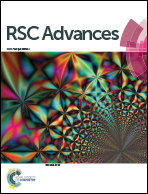A theoretical study of the catalytic mechanism of oxalyl-CoA decarboxylase, an enzyme for treating urolithiasis†
Abstract
Oxalate is harmful to many organisms by forming insoluble precipitates with some metal cations. In humans, calcium oxalate is a major constituent of kidney stones leading to urolithiasis. Oxalobacter formigenes is a bacterium in most vertebrates and can regulate the homeostasis of oxalate. Replacement therapies of O. formigenes or related-enzymes are new strategies for treating oxalate-related diseases. Oxalyl-CoA decarboxylase (OXC) is an enzyme involved in the oxalate degradation in O. formigenes. In this paper, the catalytic mechanism of OXC was investigated by using the density functional theory (DFT) method. The most likely reaction pathway, detail of elementary steps, and roles of key residues were determined. Our calculation results indicate that the decarboxylation process can proceed rapidly, which agrees well with the experimental observation. In the protonation of the HDC-ThDP intermediate, the 4-NH2 of ThDP is suggested to be the proton donor, which abstracts a proton from the nearby residue E121. The rate-limiting step is calculated to be the proton transfer from 4′-NH2 to the HDC-ThDP intermediate with an energy barrier of 21.8 kcal mol−1. However, if this pathway is blocked by mutating residue E121, the reaction may follow another mechanism, in which Y483 acts as the proton donor and uses a water molecule as a mediator. These findings can explain the experimental observation that replacement of residues Y483 or E121 significantly reduces but does not completely abolish the activity of the enzyme. Our results may provide useful information for exploring the enzymatic mechanism and developing biocatalytic applications for treating the oxalate-related diseases.


 Please wait while we load your content...
Please wait while we load your content...